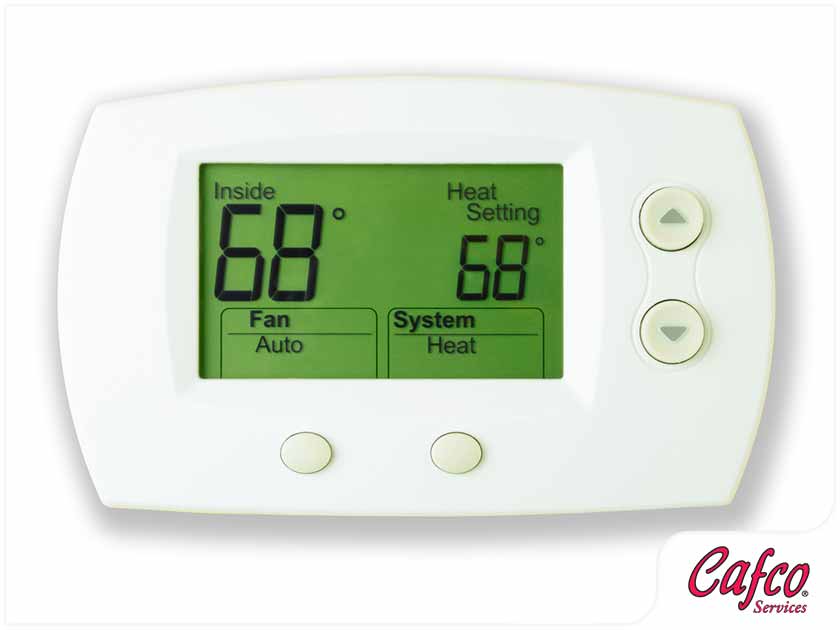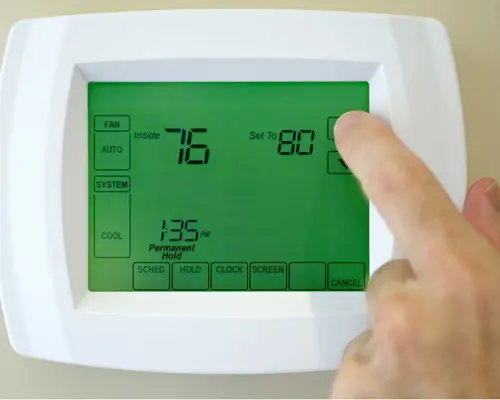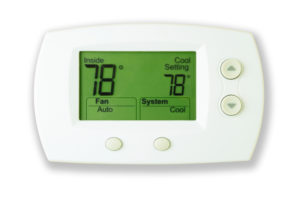Check Best Thermostat Pricing in Amazon
** As an Amazon Associate, I earn from qualifying purchases.
If you’re wondering whether to set your thermostat on auto or on, you’re not alone. Many homeowners face this decision, seeking the best way to manage comfort and efficiency.
Choosing the right thermostat setting can impact your home’s temperature control and energy use. The “auto” setting turns the system on and off as needed, while the “on” setting keeps the system running continuously. Understanding the differences can help you decide what’s best for your home.
This guide will explore the pros and cons of each option, helping you make an informed decision for optimal comfort and savings.
Thermostat Basics
Understanding how your thermostat works can make a significant difference in your home’s comfort and energy bills. A thermostat regulates the temperature inside your house, ensuring you stay warm in winter and cool in summer. But there’s often confusion about whether to set it to “Auto” or “On”. Let’s break down the basics to help you make an informed decision.
Auto Mode
Setting your thermostat to “Auto” means the system will turn on and off automatically to maintain the set temperature. This mode is energy-efficient. It only runs when necessary. Imagine coming home to a warm house in winter without the heater running all day.
Auto mode reduces wear and tear on your system. Your HVAC unit doesn’t have to work constantly. This can extend its lifespan. It’s like giving your car a break during a long drive.
However, the air circulation might not be as consistent. If you have hot or cold spots in your home, auto mode might not be the best choice. Think about your home’s layout and decide if consistent airflow is more important.
On Mode
When you set your thermostat to “On”, the system’s fan runs continuously. This ensures constant air circulation throughout your home. It’s great for even temperatures and improved air quality.
On mode can be especially useful if you have allergies. The continuous airflow can filter out dust and allergens. This can make a noticeable difference in how you feel.
But be prepared for higher energy bills. The constant running of the fan uses more electricity. Weigh the pros and cons to see if the benefits outweigh the costs for your situation.
Which mode do you prefer for your home? Have you noticed a significant difference in comfort or energy bills? Share your thoughts and experiences in the comments below. Your insights can help others make the best choice for their homes.

Credit: www.cafcoservices.com
Energy Efficiency
Energy efficiency is a critical consideration when it comes to managing your home’s heating and cooling system. Setting your thermostat to the right mode can make a huge difference in your energy bills and environmental footprint. But should you keep your thermostat on Auto or On?
Auto Mode Benefits
Auto mode is often the go-to setting for those who prioritize energy efficiency. When your thermostat is set to Auto, it automatically adjusts the heating and cooling cycles based on your desired temperature. This can save you a significant amount of energy.
Imagine coming home to a perfectly comfortable house without having to fiddle with the settings. The Auto mode does the thinking for you. It turns the system off when the desired temperature is reached and turns it back on only when necessary.
In my experience, using Auto mode has reduced my energy bills noticeably. I no longer worry about the system running unnecessarily when no one is home. Plus, it’s a set-and-forget solution that simplifies home climate control.
On Mode Drawbacks
On mode may seem convenient, but it has its downsides. When set to On, your fan will run continuously, even when your home has reached the desired temperature. This can lead to higher energy consumption.
Continuous fan operation can also wear out your HVAC system faster. You might find yourself facing more frequent maintenance issues and higher repair costs. It’s not just about the money; it’s also about the hassle and time involved in dealing with these problems.
Have you ever noticed your home feeling drafty or overly humid? That’s another drawback of the On mode. With the fan running constantly, it might not effectively remove humidity, making your home less comfortable.
So, which mode will you choose for better energy efficiency and comfort in your home?
Seasonal Adjustments
The thermostat settings in your home need adjustments for each season. This ensures comfort and energy efficiency. Seasonal adjustments can also help save on utility bills. In this section, we will explore the best settings for summer and winter.
Summer Settings
During summer, set your thermostat to “auto” mode. This helps maintain a consistent temperature. It can also prevent the system from running constantly. A recommended setting is around 78°F (26°C) when you are home. This keeps your home cool while saving energy. When you are away, set it higher. Around 85°F (29°C) can save energy without making the home too warm.
Winter Settings
In winter, “auto” mode is also beneficial. It helps regulate indoor temperatures efficiently. A good setting is around 68°F (20°C) when you are home. This keeps the house warm without overworking the system. Lower the temperature to 60°F (15°C) at night or when you are away. This can lead to significant savings on heating bills.

Credit: www.ars.com
Check Best Thermostat Pricing in Amazon
** As an Amazon Associate, I earn from qualifying purchases.
Impact On Bills
Choosing the auto setting on your thermostat can help manage energy use and lower bills. The system runs only when needed, avoiding unnecessary heating or cooling. This smart choice can lead to significant savings over time.
When it comes to managing your home’s energy bills, the setting on your thermostat can make a significant difference. Should you set it to ‘Auto’ or leave it ‘On’? Understanding the impact on your bills can help you make an informed decision. ###Cost Savings
Setting your thermostat to ‘Auto’ can lead to noticeable cost savings. When the thermostat is on ‘Auto,’ it only runs the HVAC system when needed. This means the system shuts off once your home reaches the desired temperature. It prevents the system from running continuously, which in turn conserves energy. Imagine saving those extra bucks on your monthly bill just by flipping a switch. ###Potential Expenses
On the flip side, leaving your thermostat ‘On’ can lead to potential expenses. The HVAC system will run continuously, even if the desired temperature is reached. This leads to higher energy consumption. You might notice a spike in your energy bills. Additionally, the constant running can wear out your system faster, leading to more frequent repairs. Think about the long-term costs. Is the comfort worth the extra expense? What would you do with the money you save by using the ‘Auto’ setting? Switching to ‘Auto’ can be a simple yet effective way to manage your energy bills. It saves money, reduces wear and tear, and is better for the environment. Make the smart choice and keep your finances in check.Comfort Considerations
When deciding whether to set your thermostat on auto or on, comfort considerations are vital. Your home’s comfort level is directly influenced by how you manage indoor temperature. Let’s dive into the key factors that affect this comfort, starting with consistent temperature and temperature fluctuations.
Consistent Temperature
Setting your thermostat to auto helps maintain a consistent temperature throughout the day. The system will automatically turn on and off to keep your home at your desired temperature. This means you can enjoy a comfortable environment without manually adjusting the settings.
Imagine coming home after a long day, and your house is just the right temperature. You don’t have to tinker with the thermostat because the auto setting has already done the work for you. This consistency can make a huge difference, especially during extreme weather conditions.
Temperature Fluctuations
If you set your thermostat to on, the system runs continuously. This can lead to noticeable temperature fluctuations. You might experience uneven heating or cooling in different rooms, making it hard to stay comfortable.
Consider the times you’ve felt a sudden chill or unexpected warmth. These fluctuations can be frustrating, especially when you’re trying to relax. By using the auto setting, you can minimize these ups and downs, ensuring a more stable and pleasant indoor climate.
Have you ever wondered why your living room feels perfect, but your bedroom is too hot or too cold? Temperature fluctuations can be the culprit. Addressing this can significantly enhance your home’s comfort and your overall well-being.
Maintenance Tips
Maintaining your thermostat can significantly improve its performance and lifespan. Following some simple maintenance tips ensures your system runs efficiently. Here are some practical steps to keep your thermostat in top shape.
Regular Checks
Regularly check your thermostat’s settings to ensure accuracy. Set a reminder to do this monthly. Dust can gather around the device, affecting its performance. Clean the exterior with a soft cloth. Replace the batteries twice a year to avoid unexpected shutdowns. Also, check for any software updates if your thermostat is smart. Keeping it updated ensures optimal functionality.
Professional Services
Schedule annual maintenance with a professional technician. They can inspect and clean the internal components. Professionals can also recalibrate your thermostat for precise temperature control. This service can prevent costly repairs in the future. A technician may also offer tips specific to your system. Regular professional check-ups keep your heating and cooling system running smoothly.
Smart Thermostats
Smart thermostats offer two modes: auto and on. The auto mode adjusts the temperature based on your settings, providing energy efficiency. The on mode keeps the fan running constantly, which can improve air circulation.
Smart thermostats are increasingly becoming a staple in modern homes. These advanced devices not only help maintain a comfortable temperature but also bring a host of features that make managing your home’s climate easier and more efficient. If you’re wondering whether to set your thermostat to auto or on, smart thermostats might just be the game-changer you need.Features And Benefits
Smart thermostats come packed with features designed to make your life simpler. One of the standout benefits is their ability to learn your schedule. They automatically adjust the temperature based on when you’re home or away, saving energy and cutting down on utility bills. These devices also offer remote control through smartphone apps. Imagine adjusting your home’s temperature while you’re still at work or on vacation. It’s convenient and ensures you always come back to a comfortable home. Additionally, smart thermostats provide detailed energy usage reports. This data helps you understand your consumption patterns and identify areas where you can save even more.Integration With Home Systems
Smart thermostats integrate seamlessly with other home automation systems. If you have smart speakers like Alexa or Google Home, you can control your thermostat with voice commands. This feature is particularly useful when your hands are full or you’re just too comfortable to get up. They also sync with other smart devices like lights and security systems. For instance, your thermostat can lower the temperature when your security system is armed and everyone has left the house. This ensures energy isn’t wasted heating or cooling an empty home. Moreover, many smart thermostats work with smart vents, which control the airflow in individual rooms. This means you can customize the temperature in different parts of your home, ensuring everyone is comfortable without overworking your HVAC system. Have you ever forgotten to turn off the heating before leaving for a weekend trip? With a smart thermostat, those worries are a thing of the past. These devices offer peace of mind and significant energy savings. How would you feel knowing you’re maximizing both comfort and efficiency in your home? By upgrading to a smart thermostat, you’re not just keeping your home at the ideal temperature. You’re investing in technology that simplifies your life and optimizes your energy use. Why settle for manual adjustments when you can have a smart system that does it all for you?
Credit: www.climatecare.com
User Preferences
Deciding whether to keep your thermostat on auto or on can depend on various user preferences. Every household has unique needs and habits. These factors can influence the ideal thermostat setting. Let’s explore some of these preferences.
Lifestyle Factors
Different lifestyles require different thermostat settings. Busy families may prefer the auto setting. It adjusts the temperature based on the time of day. This can save energy and reduce costs. People who work from home may like a more constant temperature. They might choose to keep the thermostat on.
Personal Comfort
Personal comfort is another important factor. Some people feel cold easily. They may prefer the thermostat to stay on. This ensures a steady temperature. Others might not mind slight fluctuations. They might find the auto setting more comfortable. It allows the temperature to vary slightly throughout the day.
Frequently Asked Questions
Is It Better To Have The Fan On Or Auto On A Thermostat?
Setting the thermostat to “auto” conserves energy, as the fan only runs when heating or cooling is needed. The “on” setting provides continuous air circulation, which can improve air quality but increases energy consumption. Choose “auto” for efficiency or “on” for consistent air movement.
Is It Better To Keep The Thermostat On Auto Or On?
It’s better to keep the thermostat on auto. This setting maintains consistent temperature and improves energy efficiency.
Is It Better To Leave Ac On Auto Or On?
Leaving AC on auto is better. It adjusts temperature and saves energy. Manual mode may use more power.
What Mode Should My Thermostat Be On?
Set your thermostat to “Heat” in winter and “Cool” in summer. Use “Auto” mode for year-round comfort.
Conclusion
Choosing between auto and on settings depends on your needs. Auto mode helps save energy and maintains comfort. The “on” setting keeps air circulating but uses more power. For most homes, auto is the best choice. It balances efficiency and comfort.
Regularly check your thermostat settings. This ensures optimal performance. Make adjustments based on weather and seasons. Smart thermostats offer more control and convenience. Consider your lifestyle and preferences. Your comfort is important. The right thermostat setting can enhance your home’s environment.
Stay mindful and enjoy a cozy living space.
Check Best Thermostat Pricing in Amazon
** As an Amazon Associate, I earn from qualifying purchases.


